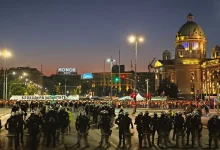The Bridge Stays initiative has called for a protest against the planned demolition of the Old Sava Bridge on October 20 at 5pm in Republic Square. The organizers came together under the United Initiatives and Movements to draw attention to the lacking legal basis for the bridge’s destruction. In an open letter, the initiative demands that the Ministry of Construction “urgently suspend the process of issuing a construction permit for the removal of the Old Sava Bridge.”
The open letter further states: “We demand that the plan to remove the bridge be put on hold until a broad social consensus is reached on the priorities for the development of transport infrastructure and urban planning in Belgrade, in the general interest of citizens. The announced demolition of the Old Sava Bridge would greatly worsen the already severe traffic problems in Belgrade. Moreover, demolishing the bridge would mean the loss of yet another symbol of Belgrade which must preserve the memory of its turbulent and freedom-loving history. In addition, it would involve an unnecessary financial burden of all Serbian citizens for the demolition of a functional bridge whose major reconstruction was already paid for by the citizens of Belgrade 15 years ago.” Numerous citizen initiatives and political organizations signed on to the letter.
The leading initiative notes that the bridge accounts for more than 6% of all traffic crossing the Sava River, contains four tram and two bus lines that transport around 20,000 passengers daily, along with a significant number of freight vehicles. Demolishing such a functional traffic route before building a completely new bridge would hinder accessing roads and lead to an overwhelming amount of traffic on other bridges. Furthermore, the letter reads: “It should be noted that Branko’s Bridge and the Gazela Bridge have for years been operating at maximum capacity.”
Lack of Legal Grounds
Belgrade does not yet have a new General Urban Plan, which is a spatial plan for the city. The Bridge Stays initiative pointed out that according to the current urban plan adopted in 2016, there is no provision for the removal of any bridge across the Sava River.
“There is no, or at least the public is not aware of, any project to construct a new bridge over the Sava. Plans for doing such have changed over the past few years without any public involvement,” the initiative says. They added that the public is also not familiar with the Project for the removal of the bridge, nor the plan for redirecting traffic from the bridge, or the Traffic Impact Study in case of its demolition.
The open letter also states: “There is presently no feasibility study for the bridge’s removal. The deliberate neglect of the Old Sava Bridge is being used to maliciously mislead the public into believing that the demolition is necessary, while deliberately making the crossing of the bridge unsafe.”
Legal and Factual Ambiguities
In its open letter to the Ministry, the initiative also submitted an attachment, referring to the Stakeholder Engagement Plan, and argue there are several legal and factual ambiguities pertaining to the bridge’s destruction. For one, they ask whether and when the Special Purpose Spatial Plan for the “Belgrade Waterfront” project was amended. They also ask on what basis the decision to build a completely new bridge was made, given the 2015 Plan includes the maintenance of the bridge.
The initiative also pointed out that in 2017, a public call was issued for the creation of an urban planning and architectural competition for the reconstruction of the Old Sava Bridge. Instead, the objective of the competition became creating a totally new bridge, not restoring the existing one.
Although a conceptual design for the construction of the new bridge was adopted in 2019, the initiative claims that the proposed parameters are unsuitable for the concrete conditions. They write in their letter, “because new buildings have since been constructed within the Belgrade Waterfront complex, this prevents the project from being implemented as was originally planned. According to experts, due to problems arising from unplanned residential construction on the right river bank, the new feasible width of the bridge on the left bank is 33.4 meters, narrowing to 27m on the right bank. This is 11 meters less than the initially proposed width of the bridge.”
The initiative also pointed out that in 2022, the Serbian Parliament approved a loan agreement of up to 79.92 million euros for this project.
Earlier this week, media reported that the Ministry had issued a permit for the removal of the Old Sava Bridge and that the bridge would be closed to traffic as of November 1. However, there is still no official confirmation of this information.
I.P.




